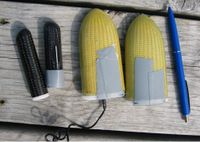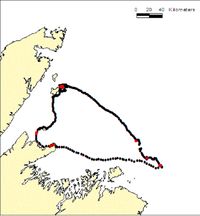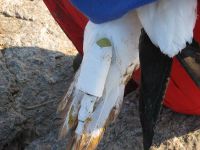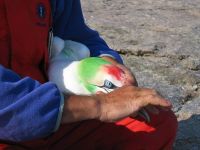Application of data loggers to seabirds
This article describes how data loggers can be used to collect a vast amount of data about seabirds. A data logger is a special type of sensor.
Contents
Introduction
Seabirds have been instrumented with telemetry devices mainly since the 1970s to learn more about seabirds and their marine environment. In the beginning, devices have been very large so that they could hardly be fitted to the largest seabirds, mainly penguins. The miniaturization process in electronic technology effectively helped to reduce the size of such devices so that more and more species can now be worked with and more and more parameters can be measured (Fig. 1).
Data loggers differ from other telemetry devices (e.g. radio-telemetry and satellite telemetry) in so far as they do not transmit information permanently or at a given interval but store information. These loggers have to be retrieved from the birds or from the sea to download the data to a computer. A brief overview of the history of this technology is given e.g. by Ropert-Coudert & Wilson (2005)[1].
Research approach
The application of data loggers to seabirds has mainly focussed on biological aspects of the birds, e.g. where they forage, where they migrate, where they dive and how deep, how high they fly and at which speed (Fig. 2). More recent studies have also investigated how seabirds use their environment as more and more environmental parameters can be collected (e.g. water temperature). It has been demonstrated that seabirds can thus passively collect a vast amount of data that may allow us to monitor the environment. Such a monitoring may focus at hydrographic structures but also at biological properties such as feeding hot-spots and productivity (overview e.g. by Wilson et al. (2002)[2]). Examples of comprehensive studies are e.g. given in Grémillet et al.(2004)[3], Weimerskirch et al. (2005)[4], Shaffer et al.(2006)[5] and Garthe et al. (2007)[6].
Ethical aspects
An essential aspect when applying data loggers to seabirds is to ensure that the bird is not suffering from the procedure. While it is virtually impossible to definitely prove that no effects have been taken place, there are a variety of measurements and observations that can be used to investigate whether the individuals involved behaved unusal. It is essential to minimise any possible adverse effects on the birds while the bird is handled and while the device is attached to the bird to not affect the birds and to guarantee that the data collected are representative and useful (see e.g. by Wilson & McMahon (2006)[7]).
Species involved
Penguins were the first seabird group instrumented with data loggers to a large extent as they are among the largest and heaviest birds, allowing more loads to be attached compared to smaller species. Albatrosses, cormorants, gannets (Figs. 3 and 4), shearwaters, petrels followed next. The on-going miniaturization process will allow more and more species to be studied by this technology.
Information forum
As part of the increasing demands to study seabirds at sea, at a time when they are usually out of sight and out of reach for researchers, conferences have been held recently. Within the so-called bio-logging science, or animal-attached remote sensing, people meet that work with seabirds, marine mammals, sea turtles and large fish.
See also
Internal links
- Counting seabirds from ships and aircraft
- Instruments and sensors to measure environmental parameters
- Acoustic monitoring of marine mammals
References
- ↑ Ropert-Coudert & Wilson, Frontiers in Ecology and Environment, 3: 437-444; 2005
- ↑ Wilson et al., Marine Ecology Progress Series, 228: 241-261; 2002
- ↑ Grémillet et al., Marine Ecology Progress Series, 268: 265-279; 2004
- ↑ Weimerskirch et al., Proceedings of the Royal Society of London, Biological Science, 272: 53-61; 2005
- ↑ Shaffer et al., Proceedings of the National Academy of Science of the US, 103: 12799-12802; 2006
- ↑ Garthe et al., Deep-Sea Research II, 54: 311-320; 2007
- ↑ Wilson & McMahon, Frontiers in Ecology and Environment, 4: 147-154; 2006
Please note that others may also have edited the contents of this article.
|



